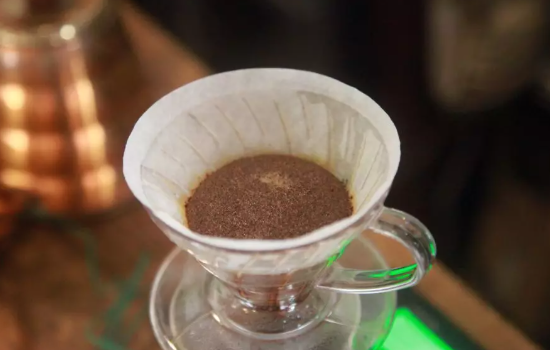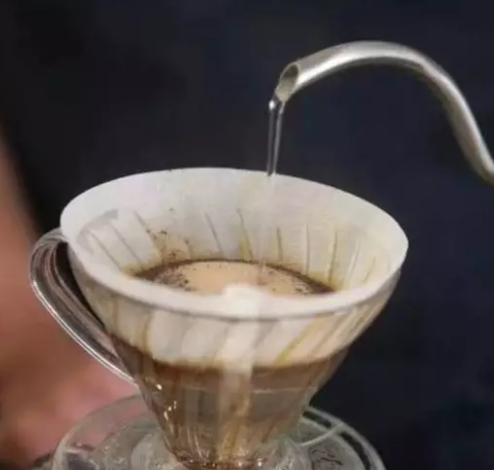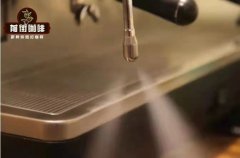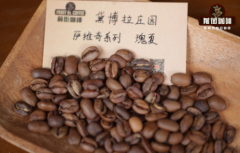Barista skills-the extraction principle of hand-brewed coffee, how to make a good cup of hand-brewed coffee.
In recent years, more and more coffee shops have launched hand-made coffee, so how to make a cup of hand-made coffee at home?
If you understand the extraction principle of hand-brewed coffee, you will understand that the principle of hand-brewing coffee is "dissolution" and "diffusion".

After roasting, coffee beans undergo a chemical reaction to produce coffee ingredients that emit coffee aroma and flavor. in order to extract these coffee ingredients, you need to grind the coffee into powder and then slowly inject water to dissolve the substance in the coffee, which is called "dissolving". In daily life, we know that if we want to dissolve better, we need to grind the powder more finely, but in hand-brewing coffee, if we grind the coffee powder very fine, it will block the filter paper. So you have to grind the coffee powder to the size of fine granulated sugar (medium to fine grinding), but in this way it will dissolve unevenly (coffee substances have small molecules that are easy to dissolve and macromolecules that are not easy to dissolve). It needs the help of "steaming", "stirring" and "shaking the sharing pot" in the extraction (there will be a concentration difference in the process of dissolving by water injection. Shake the sharing pot after extraction It is for the uniform concentration of coffee) to dissolve it and call it "diffusion".

In the process of extraction, a cup of hand-brewed coffee can be divided into three stages: the first is the aroma and acidity (flower and fruit) that can be easily extracted, the second is the sweetness and caramelization of the coffee, and the third is the bitter and astringent taste of the coffee, and what we need to do is to extract the flavor of the coffee with water. There are also three cases in the process of extraction: gold cup extraction, insufficient extraction and excessive extraction.
Gold cup extraction
Gold cup extraction is considered to fall within the ideal extraction range when the concentration of your brewed coffee is between TDS 1.2 and 1.4, and the extraction rate is also up to 18%-22%. What has not yet reached this extraction range is what we call insufficient extraction, while exceeding it means excessive extraction.
Insufficient extraction
Insufficient extraction means that there are not enough substances brought out in the extraction process, and there are still extractable substances in the coffee powder. The coffee is tasted with acidity, sweetness, salty feeling, thin taste and short aftertaste.
Excessive extraction
"excessive extraction" means that coffee powder has been in contact with water for too long, extracting too many substances that we do not want, and coffee has an obvious bitter, mixed and astringent taste.
Important Notice :
前街咖啡 FrontStreet Coffee has moved to new addredd:
FrontStreet Coffee Address: 315,Donghua East Road,GuangZhou
Tel:020 38364473
- Prev

Barista skill of the milk foam how to deal with, milk foam what skills and should pay attention to.
The dispensing of milk foam is a very important step in making a good latte. Novice baristas are easy to beat the milk very thick if they are not careful. How on earth can they dispose of a good bottle of milk foam? what affects the stability of milk bubbles is the casein colloidal particles in milk protein and the presence of whey protein casein colloidal particles to form tension on the milk surface, which is formed when steam hits the milk surface.
- Next

How are the rosy coffee beans? Evaluation of solarization flavor of Rosa rosacea by special treatment.
Panama Rose Summer Coffee Bean Deborah Manor Savage anaerobic fermented Sun Bean introduction Panama's Rose Summer Coffee has always attracted everyone's attention. In the 2004 BOP contest, Rose Summer Coffee became very popular, while in the following years of raw bean competition, Rosa Coffee almost won the championship and created a champion manor. The rosy summer of Panama will show exquisite aromas of flowers, oranges,
Related
- Beginners will see the "Coffee pull flower" guide!
- What is the difference between ice blog purified milk and ordinary milk coffee?
- Why is the Philippines the largest producer of crops in Liberia?
- For coffee extraction, should the fine powder be retained?
- How does extracted espresso fill pressed powder? How much strength does it take to press the powder?
- How to make jasmine cold extract coffee? Is the jasmine + latte good?
- Will this little toy really make the coffee taste better? How does Lily Drip affect coffee extraction?
- Will the action of slapping the filter cup also affect coffee extraction?
- What's the difference between powder-to-water ratio and powder-to-liquid ratio?
- What is the Ethiopian local species? What does it have to do with Heirloom native species?

